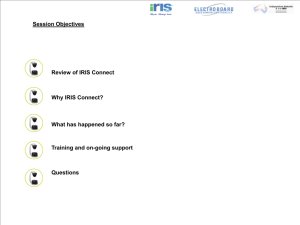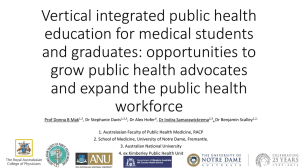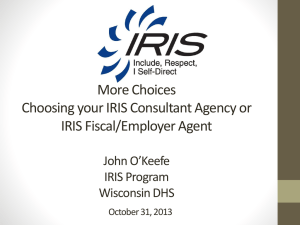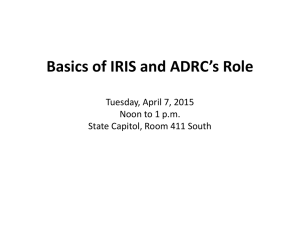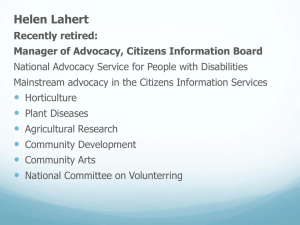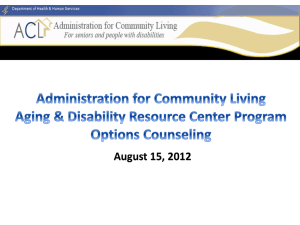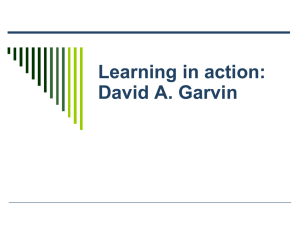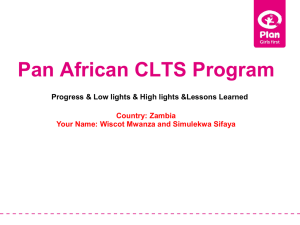Presentation
advertisement
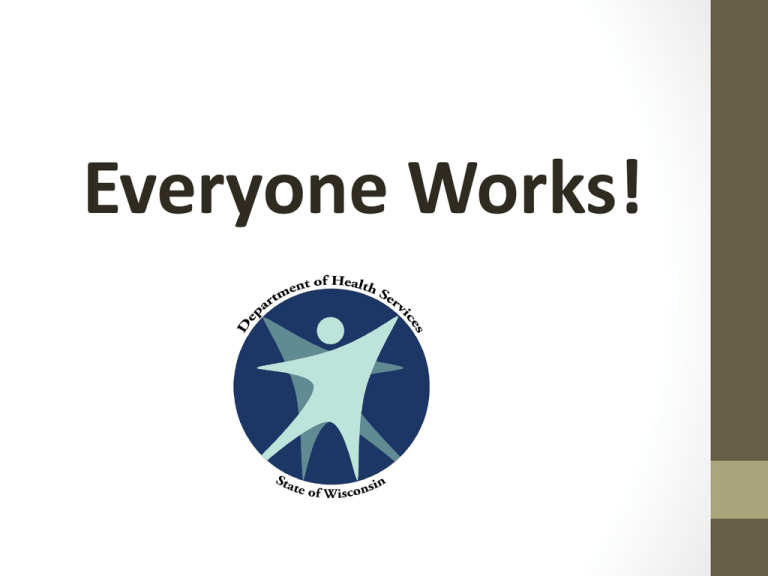
Everyone Works! Outline of Presentation • Introduction of Panel • Aging and Disability Resources (ADRC) • Children’s Long Term Support (CLTS) • Managed Care/Family Care (MCO) • IRIS (Include Respect I Self-Direct) • Employment Data • Questions • Contact Information • Resources Aging and Disability Resources Neal Minogue By 2013 every county in Wisconsin will have an ADRC . Office of Resource Center Development The Office for Resource Center Development is housed within the State of Wisconsin’s Department of Health Services, Division of Long Term Care/ Bureau for Aging And Disability Resources. The Office for Resource Center Development supports ADRC staffs throughout our state. ADRC Statistics In 2010 ADRCs had 300,000 contacts with customers throughout the year and we expect that number to reach 500,000 by the end of 2013. We expect to have 70 counties and 9 tribes operating ADRCs by the end of this year. (Oneida & Menominee Tribal start dates are unknown at present) The ADRC of Dane County is expected to open before the end of this year. (Both Door and Rock counties are expected to open ADRCs in 2013). There are currently more than 600 Information and Assistance staff employed by ADRCs both full and part-time and more than 70 Disability Benefit Specialists. Disability Benefits Specialists Each ADRC has an assigned Disability Benefit Specialists (DBS). DBS are able to give basic information about work incentive benefits to ADRC customers. In addition DBS will as needed connect people to local Work Incentive Benefits Counselors and to DVR for the funding of the counseling service. Examples of providers benefits counseling: Riverfront, ERI, and Independence First. DBS and ADRC Information and assistance staff will help people work through the process of applying and if found eligible enrollment into the LTC program of their choice. One of the benefits of LTC is employment services and support. I addition DBS are tasked helping people apply for Social Security. ARDC Resources If you are interesting in finding an ADRC in Wisconsin please look at or office website: http://www.dhs.wisconsin.gov/ltcare/adrc/ Or simply type in “ADRC Wisconsin” in your favorite web search engine Children’s Long-Term Support (CLTS) Waivers Overview Jessica Thompson Quick CLTS Waivers Overview CLTS Waivers are: • Medicaid Home and Community-Based Waivers • Administered by each county • Support children with long-term needs in their home or community • Family-centered planning and services CLTS Waivers eligibility • Developmental disabilities (DD) • Severe emotional disturbances (SED) • Physical disabilities (PD) Service plan is an Individual Support Plan (ISP) Eligibility Eligible for Special Education Eligible for CLTS Waivers Role in Transition County CLTS Waivers “Support and Service Coordinators” can: •Facilitate conversations with youth and families • Explore hopes and dreams for adult life •Encourage youth to practice self-determination by participating in their ISP development •Connect families with information and resources •Communicate across systems •Explore services to help youth develop and practice skills that are valuable as employees and adults • Daily Living Skills Training, Mentoring, Supported Employment… Eligibility for Adult Long-Term Care • Children enrolled in CLTS Waivers may not be eligible for Adult Long-Term Care Waivers • Especially youth who qualify for CLTS Waivers with an “SED Level of Care” • Youth with mental health disorders (EBD students) but no other developmental or physical disabilities BUT Aging and Disability Resource Centers (ADRCs) can still provide valuable information for these youth AND • Community mental health programs are available in each county Managed Care/Family Care Integrated Employment Tammy Hofmeister Types of Supported Employment •Integrated Employment •Group Supported Employment Integrated Employment • Working for competitive wage • Working in the community • No more than two individuals placed and supported to work together • Includes working from home • Includes self-employment Group Supported Employment • Working for competitive wage • Working in the community • Three or more individuals supported and working together which is considered a work crew or enclave Vocational Futures Planning Services (VFPS) • (VFPS) is a person-centered, team based comprehensive employment planning and support service that provides assistance for waiver program participants to obtain, maintain or advance in employment or self-employment. Service Strategies VFPS 1) Development of an employment plan based on an individualized determination of strengths, needs and interests of the individual with a disability, the barriers to work, including an assistive technology prescreen or indepth assessment, and identification of the assets a member brings to employment; 2) benefits analysis and support; 3) resource team coordination; 4) career exploration and employment goal validation; 5) job seeking support; and, 6) job follow-up and long-term support Prevocational Services • Prevocational services involve the provision of learning and work experiences where a member can develop general, nonjob-task-specific strengths and skills that contribute to employability in paid employment in integrated, community settings. • Services are expected to occur over a defined period of time as determined by the member and his/her care planning team in the ongoing member-centered planning process. • Services are expected to specifically involve strategies that enhance a participant's employability in integrated, community settings. • Competitive employment or supported employment are considered successful outcomes of prevocational services. Intent of Prevocational Services • Prevocational Services are intended to lead to participation in integrated employment • The integrated employment does not have to be fulltime • A member is not required to leave prevocational services completely • Prevocational services, if authorized, are intended to help Family Care members make reasonable and continued progress toward voluntary participation in at least part-time integrated employment Intent of Prevocational Services cont. • Voluntary participation • Good faith effort over sufficient period of time by IDT and prevocational provider is expected • Good faith effort includes identifying and addressing any concerns the member or guardian may have about the member participating in integrated employment New entrant to Prevocational Services • All members enrolled as of September 1, 2010 who did not participate in prevocational services prior to that date. • Any member who enrolls after September 1, 2010 and did not participate in prevocational services funded by the CIP waiver, the IRIS waiver or a county human service agency prior to that date. New Entrant Guidelines • Prevocational services in any setting can be authorized if the purpose is to: (1) Help the member achieve an integrated employment outcome identified in the member’s plan; (2) Provide additional “wrap-around” supports to a member who is participating in part-time integrated employment; (3) Provide a temporary safety net to a member who may lose an integrated job at some point and may need time to find a new integrated job. Family Care Employment Resources http://www.dhs.wisconsin.gov/l tcare/programops/prevoc/index .htm IRIS Participant Employment John O’Keefe IRIS Basics • Serves as CMS required choice to Family Care • Participant self directs their IRIS plan • Individual Budget based on acuity & cost neutral to FC • IRIS Consultant for each participant • IRIS Financial Services Agency pays invoices & worker wages • 80% of participants hire their own workers IRIS Choosers • 7,048 participants exceeds original estimates (10/31/12) • 44% Developmental Disability • 40% Physical Disability • 16% Frail Elders Younger people choose IRIS • Age 18-22 = 17% • Age 23-29 = 13% Family Care transfers = 18% IRIS Employment Data (4/2012) • IRIS Participant Employment (April, 2012 data) • Integrated Employment (103) • 11 hrs/week $7.51/hr • Work Crew/Enclave (21) • 9 hrs/week $3.87/hr • Facility Based Employment (149) • 13 hrs/week $2.09/hr We can and must do much better! Employment Services in IRIS • Supported Employment • Vocational Futures Planning Services • Prevocational Services • Customized Goods & Services Customized Goods and Services • IRIS Service Category definition approved by Federal Government: •Help achieve outcome related to living arrangement OR relationship OR community inclusion OR work, OR medical or functional status. •Listed on plan, allowable per Fed/State rule, no other fund obligation, not experimental • AND also either • Safety in home or community maintained or increased ;OR • Reduce Medicaid service dependence or prevents increase, OR • • Skill improves or loss prevented, OR Community access or involvement increased or maintained. Examples • Andrew • Small business related to anything worms • Mother recruits, trains & supports 1:1 job coaches • Martha • IRIS Self Directed Personal Care • Hired Personal Care worker while at work • Alexis • AJ Special Services • Video Support costs $5/hour IRIS Resources http://www.dhs.wisconsin.gov/bdds/IRIS/ index.htm 1-866-515-4747 Employment Outcomes Data and Services in Adult Long Term Care Programs Ellie Hartman Wisconsin: Developmental Disabilities Working Age (18 to 64) Integrated Employment Rates • Adult Long Term Care Functional Screen Federal Fiscal Year (FFY) 2011 • Dane County Supported Employment Summary (March 2011) Individuals with Developmental Disabilities (18 to 64) and Enrolled in Long Term Services based on Most Recent Functional Screen Distinct Count Percent Any Employment 8948 51% Community Employment 2431 14% 75 <1% Work Center Employment 5378 31% Group Employment 1955 11% 17,469 100% Home Employment Total Individuals with Functional Screen 35 Wisconsin: Physical Disabilities Working Age (18 to 64) Integrated Employment Rates • Adult Long Term Care Functional Screen Count of Individuals with Physical Disabilities (18 to 64 and no co-occurring DD, MI, or TBI) and Enrolled in Long Term Services based on Most Recent Functional Screen (FFY2011) Any Employment Community Employment Home Employment Work Center Employment Group Employment Total Individuals with Functional Screen Distinct Count 463 165 109 101 103 Percent 6% 2% 1% 1% 1% 7813 100% 36 Employment Status of Transition Age Youth (18 to 24) • Number of individuals with an adult long term care functional screen and number of these individuals with integrated employment (employed in community or home) • Number of individuals in a mental health programs with their employment status reported on the Mental Health Status Report and number of these individuals with integrated employment (competitive, supported, and temporary employment) • • • • Total (any disability) Developmental disabilities (DD) Physical Disabilities (PD) Co-occurring Mental Health (MH) Disability 37 DEVELOPMENTAL DISABILITIES (18 TO 64): LONG TERM CARE FUNDED EMPLOYMENT SERVICES • Source Long Term Care Encounter Reporting (FFY2011), HSRS (FFY 2011), and Dane County Supported Employment Report (March 2011) Individuals with Developmental Disabilities and Long Term Services (18 to 64) Count Percent Pre-Vocational Services 6013 31% Supported Employment Services Total with Long Term Care Services 3061 16% 19,182 100% 38 PHYSICAL DISABILITIES (18 TO 64): LONG TERM CARE FUNDED EMPLOYMENT SERVICES • Source Long Term Care Encounter Reporting and HSRS (FFY 2011) Employment Assistance Description as Reported on the Functional Screen for Individuals with Physical Disabilities (no DD, MI, or TBI and 18 to 64) Count Pre-Vocational Services Supported Employment Services Vocational Futures Planning and Support (VFPS) Services Total with Long Term Care Services Percent 122 1% 29 <1% 11 <1% 8420 100% 39 Employment Services of Transition Age Youth (18 to 24) • Different reporting systems (Encounter and Human Services and Reporting System aka HSRS) track the different services people receive through these long term care and mental health service systems, including pre-vocational and supported employment services. • The number of transition aged youth (18 to 24) receiving any services and employment specific services through these programs in state fiscal year 2011 are reported in the following graph. 40 PRELIMINARY PPS EMPLOYMENT OUTCOMES DATA FOR THOSE EMPLOYED (18 TO 64) • First Time Data Collected • Family Care Members and IRIS Participants • Employed according to most recent Adult Long Term Care Functional Screen • Employment Outcomes for April 2012 • 95% Response Rate • 6,602 reported whether or not individual had integrated employment goal • 3,001 (45%) “yes” • 2,235 (34%) “no” • 1,366 (21%) “unknown” • 5,879 of 6,572 (89%) Worked for at least one paid hour in April 2012 • Some were paid for activities they completed during day or residential services. (These individuals will not be included next reporting month.) 41 PRELIMINARY PPS EMPLOYMENT OUTCOMES DATA FOR EMPLOYED LONG TERM CARE PARTICIPANTS (18 TO 64) 1,510 (26%) Worked in Integrated Employment Average 43 Hours in April 2012 Average Earnings of $351.48 Average Hourly Wage of $8.01 277 (5%) Worked in Work Crew/Enclave Employment Average 40 Hours in April 2012 Average Earnings of $252.93 Average Hourly Wage of $6.39 4,542 (77%) Worked in Facility Based Employment Average 67 Hours in April 2012 Average Earnings of $149.55 Average Hourly Wage of $2.33 42 A Summary of the Vocational Service Costs in Wisconsin’s Medicaid Funded Long-Term Care System for Individuals with Developmental Disabilities (Robert Cimera, Ph.D.) • http://www.dhs.wisconsin.gov/WIpathways/pdf/ASummaryVo cationalServiceCostsWisconsin.pdf 43 An Evaluation of the Costs and Outcomes Obtained by Agency and Individual-Provided Follow Along Services (Robert Cimera, Ph.D.) • This study investigated outcomes achieved by two different methods of providing follow along services to supported employees: • (a) services provided by 31 agency-based personnel and • (b) services provided by 19 individual-provided service providers (not affiliated with adult service agencies) • Comparable demographics across six variables. • Individual-provided supported employees were more than twice as likely to have autism and multiple disabilities than agency-provided supported employees (26.3% versus 13.0% and 31.6% versus 14.4%, respectively). • Agency-provided supported employees were more likely to have offensive and self-injurious behaviors (32.2% and 18.3%) than individual-provided supported employees (26.3% and 10.5%). 44 Work Incentive Benefits Counseling (WIBC) • http://www.percthinkwork.org/resources/item/workincentive soverview 45 Questions??? Contact Information Sarah Lincoln – General Contact DHS/DLTC/BADR/OIE Sarah.Lincoln@wisconsin.gov 608-266-7974 Jessica Thompson – Children’s Long Term Support DHS/DLTC/BLTS/CSS JessicaL.Thompson@wisconsin.gov 608 267-3377 Tammy Hofmeister – Managed Care Organizations DHS/DLTC/OFCE Tammy.Hofmeister@wisconsin.gov 608 266-7251 47 Contact Information Cont. John O’Keefe– IRIS DHS/DLTC/BLTS John.OKeefe@wisconsin.gov 608 261-6749 Neal Minogue– Aging and Disability Resource Centers DHS/DLTC/BADR Neal.Minogue@wisconsin.gov 608 266-2036 Ellie Hartman– Employment Data Research DHS/DLTC/BADR/OIE Ellie.hartman@wisconsin.gov 608 266-2756
